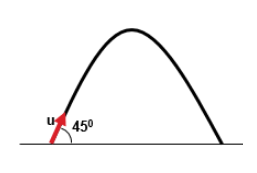Question
Question: A particle of mass m is projected with a velocity u making an angle \({45^ \circ }\) with the horizo...
A particle of mass m is projected with a velocity u making an angle 45∘ with the horizontal from level ground. When the particle lands on the level ground the magnitude of the change in momentum will be:
A. mu2
B. zero
C. 2mu
D. 2mu
Solution
In this question,we are going to apply the concept of momentum and it is defined as the product of mass and velocity of a particle in motion. It is denoted by using letter p and its SI unit is kgms−2. It is a vector quantity (it has both magnitude and direction).
Complete step by step answer:

The particle’s initial vertical velocity is usin45=2u. Since the particle is coming back to its initial position (i.e. to the level ground) we can say that its final vertical velocity is also 2u. But the final vertical velocity will be in a direction opposite to that of the initial vertical velocity.
The initial vertical velocity is +2ums−1 whereas the final vertical velocity will be −2ums−1.
Since this is a projectile motion, the horizontal component of the velocity remains constant.
Total change in momentum is the sum of change in momentum along the x and y axis.
Δp=Δpx+Δpy ⇒Δpy=m(+2u)−m(−2u) ⇒Δpy=2m(2u) ⇒Δpy=2mu Δpx=mux−mux=0 ⇒Δp=Δpx+Δpy ⇒Δp=0+2mu ∴Δp=mu2
Hence the net change in momentum in this case is mu2.
Therefore the correct choice is option (A).
Note: Here we say that the horizontal velocity remains the same by ignoring the drag forces. If we consider the drag forces, then the horizontal velocity will vary and so will the horizontal momentum.
